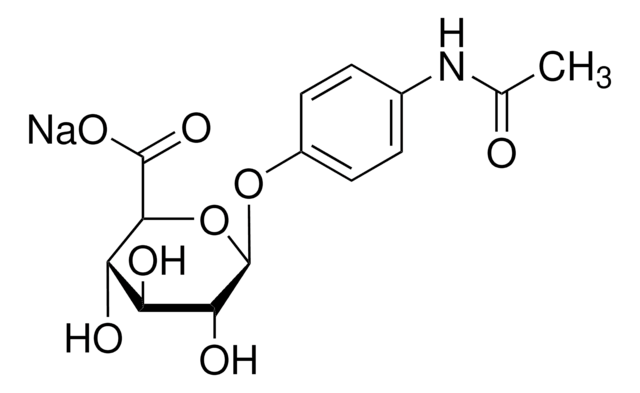A-064
Acetaminophen solution
1.0 mg/mL in methanol, ampule of 1 mL, certified reference material, Cerilliant®
About This Item
Prodotti consigliati
Grado
certified reference material
Forma fisica
liquid
Caratteristiche
SNAP-N-SPIKE®, SNAP-N-SHOOT®
Confezionamento
ampule of 1 mL
Produttore/marchio commerciale
Cerilliant®
Concentrazione
1.0 mg/mL in methanol
tecniche
gas chromatography (GC): suitable
liquid chromatography (LC): suitable
applicazioni
forensics and toxicology
Formato
single component solution
Temperatura di conservazione
−20°C
Stringa SMILE
CC(=O)Nc1ccc(O)cc1
InChI
1S/C8H9NO2/c1-6(10)9-7-2-4-8(11)5-3-7/h2-5,11H,1H3,(H,9,10)
RZVAJINKPMORJF-UHFFFAOYSA-N
Informazioni sul gene
human ... FAAH(2166) , PTGS1(5742) , PTGS2(5743) , TRPV1(7442)
Descrizione generale
This substance is listed on the positive list of the EU regulation 10/2011 for plastics intended to come into contact with food. Find all available reference materials for compounds listed in 10/2011 here
Applicazioni
- Enhanced removal of acetaminophen from aqueous solutions: A study utilized kumquat peel-derived biochar supporting zeolitic imidazole framework-67 (ZIF-67) to improve peracetic acid activation for acetaminophen removal, demonstrating an innovative approach to wastewater treatment (Nguyen et al., 2024).
- Co-doped biochar for acetaminophen degradation: Research on Cu/N co-doped biochar activating peroxymonosulfate (PMS) revealed a non-radical degradation pathway for acetaminophen dominated by singlet oxygen and electron transfer, providing insights into sustainable environmental cleanup technologies (Wu et al., 2024).
- Biodegradation of pharmaceuticals including acetaminophen: A study on anaerobic co-metabolic biodegradation of pharmaceuticals and personal care products highlighted glycerol fermentation as a driving mechanism, offering a feasible strategy for managing environmental contamination from substances like acetaminophen (Carneiro et al., 2024).
Note legali
Prodotti correlati
Avvertenze
Danger
Indicazioni di pericolo
Consigli di prudenza
Classi di pericolo
Acute Tox. 3 Dermal - Acute Tox. 3 Inhalation - Acute Tox. 3 Oral - Flam. Liq. 2 - STOT SE 1
Organi bersaglio
Eyes
Codice della classe di stoccaggio
3 - Flammable liquids
Classe di pericolosità dell'acqua (WGK)
WGK 2
Punto d’infiammabilità (°F)
49.5 °F - closed cup
Punto d’infiammabilità (°C)
9.7 °C - closed cup
Certificati d'analisi (COA)
Cerca il Certificati d'analisi (COA) digitando il numero di lotto/batch corrispondente. I numeri di lotto o di batch sono stampati sull'etichetta dei prodotti dopo la parola ‘Lotto’ o ‘Batch’.
Possiedi già questo prodotto?
I documenti relativi ai prodotti acquistati recentemente sono disponibili nell’Archivio dei documenti.
I clienti hanno visto anche
Il team dei nostri ricercatori vanta grande esperienza in tutte le aree della ricerca quali Life Science, scienza dei materiali, sintesi chimica, cromatografia, discipline analitiche, ecc..
Contatta l'Assistenza Tecnica.












